ADATA XPG SX900 (128GB) Review: Maximizing SandForce Capacity
by Kristian Vättö on June 8, 2012 1:25 AM ESTAnandTech Storage Bench 2011
Last year we introduced our AnandTech Storage Bench, a suite of benchmarks that took traces of real OS/application usage and played them back in a repeatable manner. Anand assembled the traces out of frustration with the majority of what we have today in terms of SSD benchmarks.
Although the AnandTech Storage Bench tests did a good job of characterizing SSD performance, they weren't stressful enough. All of the tests performed less than 10GB of reads/writes and typically involved only 4GB of writes specifically. That's not even enough exceed the spare area on most SSDs. Most canned SSD benchmarks don't even come close to writing a single gigabyte of data, but that doesn't mean that simply writing 4GB is acceptable.
Originally we kept the benchmarks short enough that they wouldn't be a burden to run (~30 minutes) but long enough that they were representative of what a power user might do with their system. Later, however, we created what we refer to as the Mother of All SSD Benchmarks (MOASB). Rather than only writing 4GB of data to the drive, this benchmark writes 106.32GB. This represents the load you'd put on a drive after nearly two weeks of constant usage. And it takes a long time to run.
1) The MOASB, officially called AnandTech Storage Bench 2011—Heavy Workload, mainly focuses on the times when your I/O activity is the highest. There is a lot of downloading and application installing that happens during the course of this test. Our thinking was that it's during application installs, file copies, downloading, and multitasking with all of this that you can really notice performance differences between drives.
2) We tried to cover as many bases as possible with the software incorporated into this test. There's a lot of photo editing in Photoshop, HTML editing in Dreamweaver, web browsing, game playing/level loading (Starcraft II and WoW are both a part of the test), as well as general use stuff (application installing, virus scanning). We included a large amount of email downloading, document creation, and editing as well. To top it all off we even use Visual Studio 2008 to build Chromium during the test.
The test has 2,168,893 read operations and 1,783,447 write operations. The IO breakdown is as follows:
| AnandTech Storage Bench 2011—Heavy Workload IO Breakdown | ||||
| IO Size | % of Total | |||
| 4KB | 28% | |||
| 16KB | 10% | |||
| 32KB | 10% | |||
| 64KB | 4% | |||
Only 42% of all operations are sequential; the rest ranges from pseudo to fully random (with most falling in the pseudo-random category). Average queue depth is 4.625 IOs, with 59% of operations taking place in an IO queue of 1.
Many of you have asked for a better way to really characterize performance. Simply looking at IOPS doesn't really say much. As a result we're going to be presenting Storage Bench 2011 data in a slightly different way. We'll have performance represented as Average MB/s, with higher numbers being better. At the same time we'll be reporting how long the SSD was busy while running this test. These disk busy graphs will show you exactly how much time was shaved off by using a faster drive vs. a slower one during the course of this test. Finally, we will also break out performance into reads, writes, and combined. The reason we do this is to help balance out the fact that this test is unusually write intensive, which can often hide the benefits of a drive with good read performance.
There's also a new light workload for 2011. This is a far more reasonable, typical every day use case benchmark. It has lots of web browsing, photo editing (but with a greater focus on photo consumption), video playback, as well as some application installs and gaming. This test isn't nearly as write intensive as the MOASB but it's still multiple times more write intensive than what we were running last year.
We don't believe that these two benchmarks alone are enough to characterize the performance of a drive, but hopefully along with the rest of our tests they will help provide a better idea. The testbed for Storage Bench 2011 has changed as well. We're now using a Sandy Bridge platform with full 6Gbps support for these tests.
AnandTech Storage Bench 2011 - Heavy Workload
We'll start out by looking at average data rate throughout our new heavy workload test:
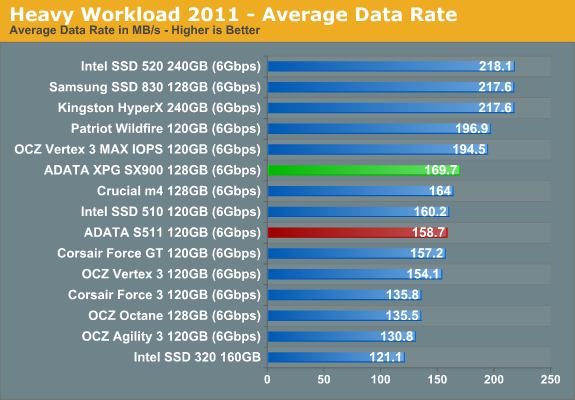
The SX900 is slightly faster than the Vertex 3 and Force GT here, which is most likely due to the newer firmware as I noted in the incompressible sequential read/write speed section. I asked Anand to test a 120GB ADATA S511, which is based on the same SF-2281 controller and utilizes 25nm Intel MLC NAND. The SX900 and S511 should be as similar as possible; however, they don't share the same firmware version. The SX900 is reported to have firmware version 5.0.1 in Device Manager, whereas the S511 Anand tested was running 3.2.2. That's the most current firmware for the S511 and it dates back to November 2011, so this is likely the reason for the difference in performance.
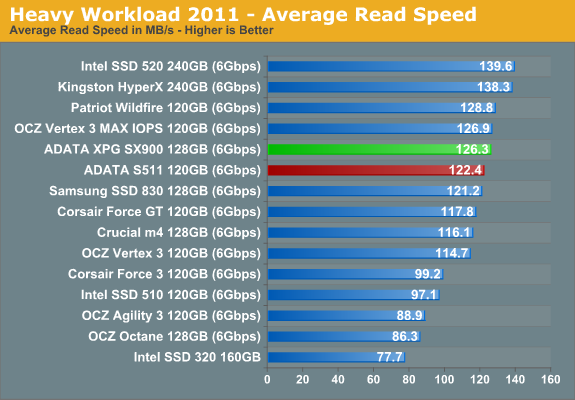
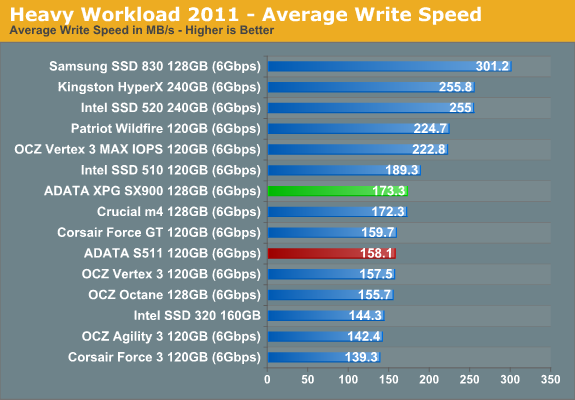
The next three charts just represent the same data, but in a different manner. Instead of looking at average data rate, we're looking at how long the disk was busy for during this entire test. Note that disk busy time excludes any and all idles, this is just how long the SSD was busy doing something:
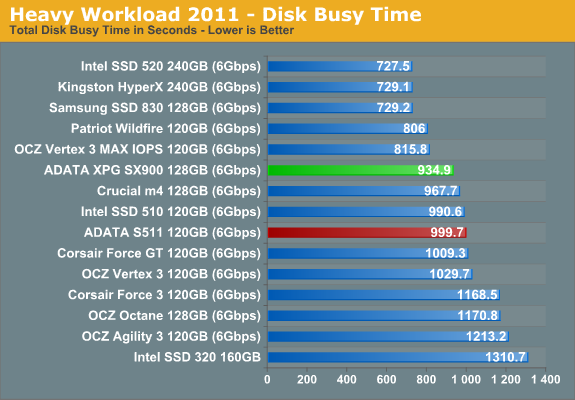
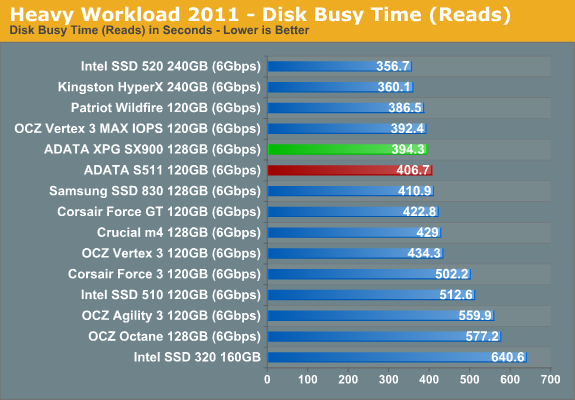
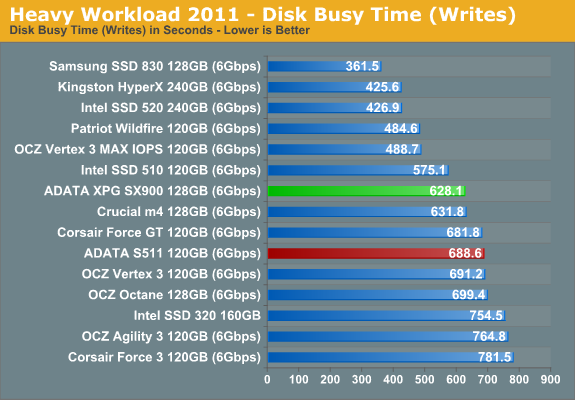










58 Comments
View All Comments
kevith - Friday, June 8, 2012 - link
I'l second that, I had exactly the same experience.Proper good job, mate!
Whyaskwhy - Friday, June 8, 2012 - link
My knowledge is very limited, can you show me how each SSD compares playing online games? I play Rift, SWTOR, World of Tanks,and will be playing GW2 when it comes out.JarredWalton - Friday, June 8, 2012 - link
Generally speaking, SSDs only improve game and level load times, and even then the difference may not be that large. If you have a PC with 4GB RAM or more, SSDs are really about improving Windows performance and responsiveness as opposed to improving gaming performance.CeriseCogburn - Monday, June 11, 2012 - link
Buy a sata3 6.0 (no matter your board speed), and you'll be fine - your frame rate won't go up a lot in games, although it does rise substantially (10%-40%) in some like flight sim (lots of tiny files to be accessed) and a bit in all others...What's good about them is not waiting for drive swapping IN GAME - so they can make a difference in responsiveness, it will be noticeable.
If you are a benchmark freak make certain you buy a 120gig (or 128) not a 60gig (or 64) as the 60gigs bench poorly because of fewer ram chip channels, however windows 7 and all the general goodies and several (3) large games fit on a 60 or 64 just fine, but a 120/128 is barely 30 bucks more, so spend $100 and get a 120.
The samsung 830's are hot but costly, I prefer 2281 sandforce asynchronus as they have several brand choices at the lowest of prices with excellent speed.
If you have a single spindle drive non raid boot you won't be sorry at all. It appears on P45 chipsets and above, a triple raid boot zero stripe is required before equal performance responsiveness is met (on sata 2).
So there you are - use the egg to see speed and click the reviews tab there and sort by most helpful you will see actual purchasers being quite helpful and giving their tested stats.
jaydee - Friday, June 8, 2012 - link
I don't know if it was really worth all the analysis on the pricing, as it fluctuates so much. At any given time, it seems that you can get a 120/128GB drive for ~$100-110, last week it was Samsung, this week it's Crucial, I've seen Plextor there too, and at least one SandForce drive seems to be there perpetually.Not that I'm complaining about the prices, its great for the consumers, but it places an impossible burden on a reviewer to evaluate the bang-for-buck, because it changes daily.
Mathieu Bourgie - Friday, June 8, 2012 - link
Thank you for the review Kristian.On a related note, I'm curious as to what happened to the Plextor M3 Pro review?
You commented on May 14th, in the Corsair Performance Series Pro (256GB) Review article that the "review should be up next week at the latest." and yet here we are nearly a month later with a review of a different SSD.
Thanks,
Mathieu
Kristian Vättö - Friday, June 8, 2012 - link
It's been ready for about a month now. Only pricing table and final words are missing, but those can't be done until just before publishing. I wanted to get this review out of the way because I've had the drive for months. I asked Anand to test an updated 120GB SF drive for comparisons (it's been a while since we reviewed a 120GB SF drive, that's why), which took a bit longer than I thought (Anand is a very, very busy man ;-)).I will finish the M3P review this weekend and it will hopefully be up next week, depending on Anand's schedule and what else we have for next week (we don't want to post five reviews at once and then have nothing for the rest of the week. It's problematic when there are NDAs because they must go live ASAP, whereas other articles can wait).
swx2 - Friday, June 8, 2012 - link
Ah! I was looking for that review as well, but thanks for the explanation :)TwistedKestrel - Friday, June 8, 2012 - link
I could have sworn that RAISE was disabled on the 120 GB Intel 520... and I thought I read that here, but I see no mention of it in Anandtech's review.Airkol - Friday, June 8, 2012 - link
Reducing the over-provisioning and shutting RAISE off my give the consumer a few extra bytes of storage. But what it costs them is the life of the drive. The write amplification of the drive will increase since there is less area to manage wear leveling.
This could reduce the life of the drive by 50%-75% depending on what type of data is being written.